| You are here: Home » The Marketing Diary » Column: Direct-to-Desktop Marketing » What is Relevant Content? What is Relevant Content? There has always been talk about how content is king on the internet. That, quite naturally, is true. However, reaching our goals and at the same time best serving our visitors requires relevant content. But what is relevant content in the first place? [to better understand the following, please take a look at the figure at the end of this article] a] It corresponds to informational demands of the target audiences it is intended for, in correlation with our specific area of expertise, the audiences' expectations towards us and our goals. The content delivery channel of our choice should answer all or most of these requirements. RSS, for instance, does. However, relevant content also has a fifth requirement: e] Is available to our target audiences using exactly the content consumption channel that best suits their preferences and needs. This basically means that it's our audiences that should have the power to choose how content is going to be delivered to them. We should not for instance force our audiences to receive content from us only using e-mail as the content delivery channel, and certainly not only using RSS, or any content delivery channel for that matter. This goes for the entire internet as well. The point is that content should be delivered using whichever channels are the most appropriate for our target audience and our goals, which does not exclude traditional content delivery channels, such as, for instance, postal mail.
Related Articles -->
|

Read about real-life marketing and project management experience, views and results. Follow our projects and see what worked and what didn't and especially what you can learn from our mistakes and successes. Edited by Rok Hrastnik Unleash the Marketing & Publishing Power of RSS
The e-book that is defining RSS marketing.
|
 |
|
|






